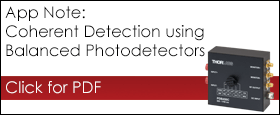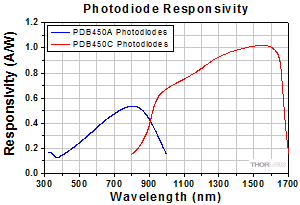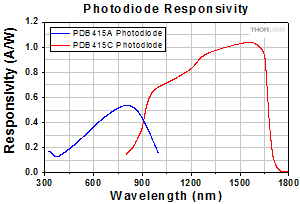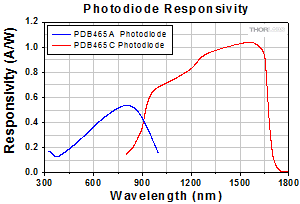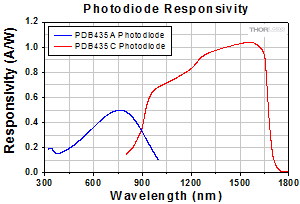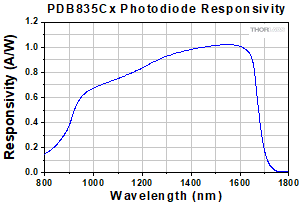
Balanced Amplified Photodetectors with Fast Monitor Output
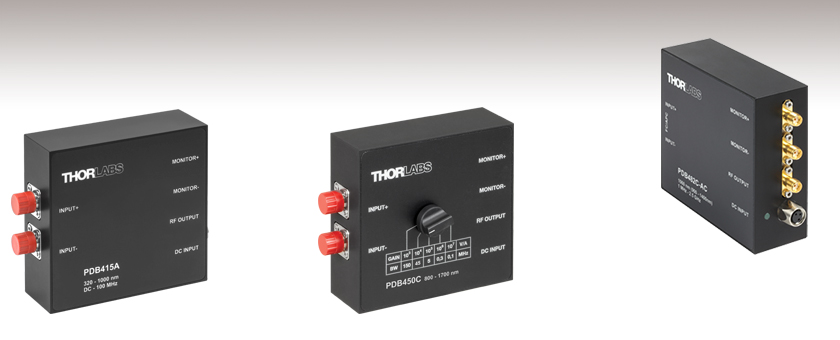
- Models Available with Bandwidths Up to 2.5 GHz
- Noise Cancellation by Subtraction of 2 Input Signals
- >20 dB Common Mode Rejection Ratio
- Fast Monitor Outputs
PDB415A
Fixed Gain, 100 MHz, Si
Optical Inputs Shown
PDB450C
Switchable Gain, InGaAs
Optical Inputs Shown
PDB482C-AC
Fixed Gain, 2.5 GHz, InGaAs, AC Coupled
Electrical Outputs Shown
OVERVIEW
| Balanced Detector Selection Guide |
|---|
| Balanced Detectors with Fast Monitor Output |
| Large-Area Balanced Amplified Detectors |
| Suitable for OCT |
| Compact Balanced Amplified Detectors |
| Compact 5 GHz Balanced Detectors |
| OCT Balanced Detectors with Fast Monitor Output |
| Auto-Balanced Detector with Avalanche Photodiodes |
| Polarization-Dependent Balanced Detector |
Typical Applications
- Spectroscopy
- Heterodyne Detection
(See Doppler LIDAR Tab) - Optical Coherence Tomography OCT
- Optical Delay Measurements
- THz Detection
| Balanced Detector with Fast Monitor Output | |||
|---|---|---|---|
| Bandwidth | Available Wavelength Ranges |
Fast Monitor Output Bandwidth |
Gain |
| Switchable (DC - 0.1, 0.3, 4, 45, or 150 MHz) |
320 to 1000 nm or 800 - 1700 nm |
DC - 1 MHz | Switchable |
| DC - 15 MHz | Fixed | ||
| DC - 75 MHz | |||
| DC - 100 MHz | |||
| DC - 200 MHz | |||
| DC - 350 MHz | |||
| DC - 400 MHz | Optimized for 1060 nm (900 - 1400 nm Range) or Optimized for 1300 nm (1200 - 1700 nm Range) |
DC - 3 MHz | |
| DC - 500 MHz | 800 - 1700 nm | DC - 1 MHz | |
| 30 kHz - 1.0 GHz | Optimized for 1060 nm (900 - 1400 nm Range) |
DC - 3 MHz | |
| 30 kHz - 1.6 GHz | Optimized for 1300 nm (1200 - 1700 nm Range) |
DC - 3 MHz | |
| 1 MHz - 2.5 GHz | Optimized for 1060 nm (900 - 1400 nm Range) |
DC - 2.5 MHz | |
Features
- Four Wavelength Ranges Available
- 320 - 1000 nm
- 800 - 1700 nm
- 900 - 1400 nm (Optimized for 1060 nm)
- 1200 - 1700 nm (Optimized for 1300 nm)
- >20 dB Common Mode Rejection Ratio
- Fast Monitor Outputs
- Choose a Si or InGaAs Detector
- FC Fiber Inputs Available in All Versions
- Free-Space Inputs Available on Some Detectors (See Below for Details)
- Switchable Power Supply Included
- Switchable Transimpedance Gain Version Available
These balanced photodetectors act as a balanced receiver by subtracting the two optical input signals from each other, resulting in the cancellation of common mode noise. This allows small changes in the signal path to be extracted from the interfering noise floor.
The detectors consist of two balanced photodiodes and an ultra-low-noise, high-speed transimpedance amplifier. The two photodiodes are matched to achieve an excellent common mode rejection ratio (CMRR), leading to better noise reduction. Please see the Operation tab for more details. All of these detectors incorporate three female SMA electrical ports for reduced noise. In addition to the RF-output from the transimpedance amplifier, the Monitor+ and Monitor- ports allow the response of each photodiode to be observed individually.
To block the CW component (the unmodulated part) of the optical input signal, an AC-coupled version of each detector is offered. Note that the PDB480C-AC, PDB481C-AC, and PDB482C-AC are only available AC coupled. This improves the ability to measure a comparably weak, frequency-modulated signal over a strong CW background signal that could saturate the amplifier. The lower cut-off frequency for the AC-coupled versions, with exception to the PDB480C-AC, PDB481C-AC, PDB482C-AC, and PDB835-AC, is guaranteed to be ≤100 Hz, but will typically be below 5 Hz.
Bandwidths up to 350 MHz
Detectors with bandwidths of DC - 350 MHz or lower are available with either Si or InGaAs photodiodes for the 320 - 1000 nm or 800 - 1700 nm range, respectively. The inputs on these detectors are not fiber coupled to the photodiodes and come with two removable FC input connectors, making them suitable for either free-space or fiber applications. Although the PDB465 and PDB435 detectors also contain non-fiber-coupled sensors, the FC/PC adapters at the inputs cannot be removed.
Housed in a shielded aluminum enclosure measuring 85 mm x 80 mm x 30 mm, these detectors are post mountable using the included adapter plate, which can be attached to the bottom or side of the housing with the included M2 screws.
Bandwidths of 400 MHz and Higher (Excluding PDB835 Series)
Detectors with bandwidths of DC - 400 MHz or higher other than PDB835 series detectors feature fiber-coupled photodiodes connected to FC/APC optical inputs with exactly length-matched SMF-28e+ or HI1060 fiber to achieve excellent CMRR values across the full detector bandwidth. All of these detectors incorporate InGaAs photodiodes and are optimized for either 1060 nm (900 - 1400 nm range) or 1300 nm (1200 - 1700 nm range). The fiber-coupled design suppresses line artifacts in the OCT image, which generally occur when detector coupling optics are used.
Our highest bandwidth balanced detectors (PDB480C-AC, PDB481C-AC, and PDB482C-AC) are offered in an AC version only. They offer bandwidths up to 2.5 GHz, leading to considerable speed improvements. The ultra-low-distortion output stage supports up to a 2 Vp-p A/D card input range, which, combined with the fiber-coupled design, improves the image quality for OCT applications considerably.
Housed in a shielded aluminum enclosure measuring 85 mm x 80 mm x 30 mm, these detectors are post mountable using the included adapter plate, which can be attached to the bottom or side of the housing with the included M2 screws.
PDB835 Series Ultra-Low-Noise, Artifact-Free Detectors (DC - 500 MHz)
The PDB835C and PDB35C-AC detectors feature free-space InGaAs photodiodes connected to FC/APC optical inputs for the 800 - 1700 nm range. Their transimpedance amplifiers feature ultra-low noise over their entire operating bandwidth (up to 500 MHz; see the Specs tab for details on the minimum NEP). These detectors feature FC/APC connectors which are individually aligned to the photodiode and achieve artifact-free operation. Each detector features a compact 76.7 mm x 60.0 mm x 20.0 mm housing with 8-32 (M4 x 0.7) combi-thread mounting holes on the top and bottom sides for universal mounting.
Power Supply
Each detector is powered by the included ±12 V DC power supply, for which a replacement is available below.
Thorlabs also offers Fiber-Based Interferometers, which feature an integrated balanced detector. If you are primarily interested in using our balanced detectors with OCT systems, a condensed list of detectors suitable for this application can be found here.
SPECS
| Item # | PDB415A(-AC) | PDB415C(-AC) | PDB425A(-AC) | PDB425C(-AC) | PDB435A(-AC) | PDB435C(-AC) |
|---|---|---|---|---|---|---|
| Detector Type | Si/PIN | InGaAs/PIN | Si/PIN | InGaAs/PIN | Si/PIN | InGaAs/PIN |
| Wavelength Range | 320 - 1000 nm | 800 - 1700 nm | 320 - 1000 nm | 800 - 1700 nm | 320 - 1000 nm | 800 - 1700 nm |
| Max Responsivity (Typical) | 0.53 A/W | 1.0 A/W | 0.53 A/W | 1.0 A/W | 0.50 A/W | 1.0 A/W |
| Active Detector Diameter | 0.8 mm | 0.3 mm | 0.8 mm | 0.3 mm | 0.4 mm | 0.15 mm |
| Bandwidth (3 dB) | DC - 100 MHz AC Coupled (-AC Suffix): 100 Hz - 100 MHz |
DC - 75 MHz AC Coupled (-AC Suffix): 100 Hz - 75 MHz |
DC - 350 MHz AC Coupled (-AC Suffix): 100 Hz - 350 MHz |
|||
| Common Mode Rejection Ratio | >25 dB | >35 dB | >20 dB | |||
| Transimpedance Gaina | 50 x 103 V/A | 250 x 103 V/A | 10 x 103 V/A | |||
| Minimum NEPb | 12.03 pW/Hz1/2 (DC - 100 MHz) |
6.99 pW/Hz1/2 (DC - 100 MHz) |
9.5 pW/Hz1/2 (DC - 75 MHz) |
5.2 pW/Hz1/2 (DC - 75 MHz) |
32.3 pW/Hz1/2 (DC - 350 MHz) |
15.28 pW/Hz1/2 (DC - 350 MHz) |
| RF Output | ||||||
| Conversion Gain RF Outputa,c | 26.5 x 103 V/W | 50 x 103 V/W | 133 x 103 V/W | 250 x 103 V/W | 5 x 103 V/W | 10 x 103 V/W |
| CW Saturation Power RF Output | 135 µW @ 820 nm | 72 µW @ 1550 nm | 27 µW @ 820 nm | 15 µW @ 1550 nm | 720 µW @ 820 nm | 360 µW @ 1550 nm |
| Impedance | 50 Ω | |||||
| Max Voltage Swing | ±1.8 V for 50 Ω Load ±3.6 V for High-Impedance Load |
|||||
| DC Offset | < ±3 mV | |||||
| RF-Output Coupling | DC or AC | |||||
| Monitor Outputs | ||||||
| Conversion Gain Monitor Outputs | 10 V/mW @ 820 nm | 10 V/mW @ 1550 nm | 10 V/mW @ 820 nm | 10 V/mW @ 1550 nm | 10 V/mW @ 820 nm | 10 V/mW @ 1550 nm |
| Impedance | 220 Ω | |||||
| Max Voltage Swing | 1.55 V for 50 Ω Load 10 V for High-Z Load |
|||||
| Bandwidth | DC to 1 MHz | |||||
| Voltage Noise | <180 µVRMS | |||||
| DC Offset | < ±2 mV | |||||
| General | ||||||
| Fiber Optical Inputsd | FC/PC or FC/APC (Removable) |
FC/PC or FC/APC (Not Removable) |
||||
| Photodiode Damage Threshold | 20 mW | |||||
| Electrical Outputs | SMA (Qty. 3) | |||||
| Dimensions | 85 mm x 80 mm x 30 mm (3.35" x 3.15" x 1.18") | |||||
| Weight | 0.35 kg (without Power Supply) | |||||
| Operating Temperature Rangee | 0 to 40 °C |
|||||
| Storage Temperature Range | -40 to 70 °C | |||||
| Included Power Supplyf | ±12 V @ 250 mA (100/120/230 VAC, 50 - 60 Hz, Switchable) |
|||||
| Item # | PDB440A(-AC) | PDB440C(-AC) | PDB450A(-AC) | PDB450C(-AC) | PDB465A(-AC) | PDB465C(-AC) |
|---|---|---|---|---|---|---|
| Detector Type | Si/PIN | InGaAs/PIN | Si/PIN | InGaAs/PIN | Si/PIN | InGaAs/PIN |
| Wavelength Range | 320 - 1000 nm | 800 - 1700 nm | 320 - 1000 nm | 800 - 1700 nm | 320 - 1000 nm | 800 - 1700 nm |
| Max Responsivity (Typical) | 0.53 A/W | 1.0 A/W | 0.53 A/W | 1.0 A/W | 0.50 A/W | 1.0 A/W |
| Active Detector Diameter | 0.8 mm | 0.3 mm | 0.8 mm | 0.3 mm | 0.8 mm | 0.15 mm |
| Bandwidth (3 dB) | DC - 15 MHz AC Coupled (-AC Suffix): 100 Hz - 15 MHz |
DC - 150, 45, 4, 0.3, 0.1 MHz AC Coupled (-AC Suffix): 100 Hz - 150, 45, 4, 0.3, 0.1 MHz |
DC - 200 MHz AC Coupled (-AC Suffix): 100 Hz - 200 MHz |
|||
| Common Mode Rejection Ratio | >35 dB | >25 dB | >25 dB | |||
| Transimpedance Gaina | 51 x 103 V/A | 103, 104, 105, 106, 107 V/A | 30 x 103 V/A | |||
| Minimum NEPb | 6.9 pW/Hz1/2 (DC - 15 MHz) |
3.9 pW/Hz1/2 (DC - 15 MHz) |
DC - 0.1 MHz: 1.4 pW/Hz1/2 DC - 0.3 MHz: 1.1 pW/Hz1/2 DC - 4.0 MHz: 3.3 pW/Hz1/2 DC - 45 MHz: 28.9 pW/Hz1/2 DC - 150 MHz: 123 pW/Hz1/2 |
DC - 0.1 MHz: 0.7 pW/Hz1/2 DC - 0.3 MHz: 0.5 pW/Hz1/2 DC - 4.0 MHz: 1.55 pW/Hz1/2 DC - 45 MHz: 14.9 pW/Hz1/2 DC - 150 MHz: 68.6 pW/Hz1/2 |
22.86 pW/Hz1/2 (DC - 200 MHz) |
8.52 pW/Hz1/2 (DC - 200 MHz) |
| RF Output | ||||||
| Conversion Gain RF Outputa,c | 27 x 103 V/W | 51 x 103 V/W | 0.53 x 103 V/W, 0.53 x 104 V/W, 0.53 x 105 V/W, 0.53 x 106 V/W, 0.53 x 107 V/W |
103 V/W, 104 V/W, 105 V/W, 106 V/W, 107 V/W |
16 x 103 V/W | 30 x 103 V/W |
| CW Saturation Power RF Output | 130 µW @ 820 nm | 70 µW @ 1550 nm | 9 mW @ 820 nm | 4.5 mW @ 1550 nm | 225 µW @ 820 nm | 120 µW @ 1550 nm |
| Impedance | 50 Ω | |||||
| Max Voltage Swing | ±1.8 for 50 Ω Load ±3.6 V for High-Impedance Load |
±4.6 V (103 to 106 Gain)a ±10 V (107 Gain)a |
±1.8 for 50 Ω Load ±3.6 V for High-Impedance Load |
|||
| DC Offset | < ±3 mV | < ±15 mV | < ±3 mV | |||
| RF-Output Coupling | DC or AC | |||||
| Monitor Outputs | ||||||
| Conversion Gain Monitor Outputs | 10 V/mW @ 820 nm | 10 V/mW @ 1550 nm | 10 V/mW @ 820 nm | 10 V/mW @ 1550 nm | 10 V/mW @ 820 nm | 10 V/mW @ 1550 nm |
| Impedance | 220 Ω | |||||
| Max Voltage Swing | 1.55 V for 50 Ω Load 10 V for High-Z Load |
|||||
| Bandwidth | DC to 1 MHz | |||||
| Voltage Noise | <180 µVRMS | |||||
| DC Offset | < ±2 mV | |||||
| General | ||||||
| Fiber Optical Inputsd | FC/PC or FC/APC (Removable) |
FC/PC or FC/APC (Not Removable) |
||||
| Photodiode Damage Threshold | 20 mW | |||||
| Electrical Outputs | SMA (Qty. 3) | |||||
| Dimensions | 85 mm x 80 mm x 30 mm (3.35" x 3.15" x 1.18") | |||||
| Weight | 0.35 kg (without Power Supply) | |||||
| Operating Temperature Rangee | 0 to 40 °C |
|||||
| Storage Temperature Range | -40 to 70 °C | |||||
| Included Power Supplyf | ±12 V @ 250 mA (100/120/230 VAC, 50 - 60 Hz, Switchable) |
|||||
| Item # | PDB470C(-AC)a | PDB471C(-AC)a | PDB480C-ACa | PDB481C-ACa | PDB482C-ACa | PDB835C(-AC)a |
|---|---|---|---|---|---|---|
| Detector | ||||||
| Detector Type | InGaAs/PIN | |||||
| Optical Inputs | FC/APC | |||||
| Internal Coupling Fiber | SMF-28e+ | HI1060 | SMF-28e+ | HI1060 | None | |
| Coupling Loss | <0.5 dB (<0.3 dB Typ.) | <1.0 dB (<0.4 dB Typ.) | <0.5 dB (<0.3 dB Typ.) | <1.0 dB (<0.4 dB Typ.) | N/A | |
| Operating Wavelength | Optimized for 1300 nm (1200 - 1700 nm Range) |
Optimized for 1060 nm (900 - 1400 nm Range) |
Optimized for 1300 nm (1200 - 1700 nm Range) |
Optimized for 1060 nm (900 - 1400 nm Range) |
800 - 1700 nm | |
| Responsivity (Typical) | 0.9 A/W @ 1550 nm | 0.72 A/W @ 1060 nm | 0.9 A/W @ 1550 nm | 0.72 A/W @ 1060 nm | 1.0 A/W @ 1550 nm | |
| Active Detector Diameter | 0.075 mm | 0.080 mm | 0.075 mm | 0.08 mm | ||
| Optical Back Reflection | <-40 dB | N/A | ||||
| Photodiode Damage Threshold |
10 mW | 5 mW | 10 mW | 5 mW | 20 mW | |
| RF OUTPUT | ||||||
| RF OUTPUT Bandwidth (3 dB) | DC - 400 MHz AC Coupled (-AC Suffix): 100 Hz - 400 MHz |
30 kHz - 1.6 GHz | 30 kHz - 1.0 GHz | 1 MHz - 2.5 GHz | DC - 500 MHz AC Coupled (-AC Suffix): 1 kHz - 500 MHz |
|
| Common Mode Rejection Ratio | >25 dB (Typ. >30 dB) | >20 dB (Typ. >25 dB) | >25 dB | |||
| RF OUTPUT Transimpedance Gain | 10 x 103 V/Ab | 16 x 103 V/Ac | 28 x 103 V/Ac | 10 x 103 V/Ad | ||
| RF OUTPUT Conversion Gain | 9 x 103 V/W @ 1550 nmb |
7.2 x 103 V/W @ 1060 nmb |
14.4 x 103 V/W @ 1550 nmc |
11.5 x 103 V/W @ 1060 nmc |
20 x 103 V/W @ 1060 nmc |
10 x 103 V/W @ 1550 nmd,e |
| RF OUTPUT Power at 1 dB Compressionc |
- | +16.5 dBm Min +18 dBm Typ. |
- | |||
| RF OUTPUT CW Saturation Power | 420 µW @ 1550 nm | 530 µW @ 1060 nm | See Note Below | 360 mW @ 1550 nm | ||
| RF OUTPUT Coupling | DC or AC | AC Coupling Only | DC or AC | |||
| RF OUTPUT Impedance | 50 Ω | |||||
| Max Voltage Swing | ±1.9 V for 50 Ω Load ±3.8 V for High-Z Load |
See Note Below | ±1.8 V for 50 Ω Load; ±3.6 V (Linear Over 0 to 2.5 V) for High-Z Load |
|||
| Minimum NEPf | 8 pW/Hz1/2 (DC to 100 MHz) |
9.3 pW/Hz1/2 (30 kHz to 100 MHz) |
9.0 pW/Hz1/2 (30 kHz to 100 MHz) |
12.0 pW/Hz1/2 (1 MHz to 100 MHz) |
6.5 pW/Hz1/2 (DC to 500 MHz) |
|
| Overall Output Voltage Noise | <2.0 mVRMS | <9 mVRMS | <6.5 mVRMS | <12 mVRMS | <1.5 mVRMS | |
| DC Offset | N/A | < ±5 mV | ||||
| MONITOR Outputs | ||||||
| MONITOR Output Impedance | 200 Ω | |||||
| MONITOR Output Bandwidth (3 dB) | DC - 3 MHz | DC - 2.5 MHz | DC - 1 MHz | |||
| MONITOR Output Conversion Gain, High Z Loadb |
9 V/mW @ 1550 nm | 7.2 V/mW @ 1060 nm | 9 V/mW @ 1550 nm | 7.2 V/mW @ 1060 nm | 10 V/mW @ 1550 nme | |
| MONITOR Output Voltage Swing |
10 V Max, High Z Load | 1.5 V Max for 50 Ω Load 10 V Max (Linear Over 0 to 5 V) for High-Z Load |
||||
| Overall Output Voltage Noise | <0.65 mVRMS | <0.6 mVRMS | ||||
| DC Offset | < ±2 mV | < ±5 mV | ||||
| General | ||||||
| Electrical Outputs | SMA | |||||
| Included DC Power Supplyg | ±12 V @ 250 mA (100/120/230 VAC, 50 - 60 Hz, Switchable) |
|||||
| Operating Temperature Rangeh | 0 °C to 40 °C | |||||
| Storage Temperature Range | -40 °C to 70 °C | |||||
| Dimensions (W x H x D) | 85 mm x 80 mm x 30 mm (3.35" x 3.15" x 1.18") |
76.7 mm x 60.0 mm x 20.0 mm (3.02" x 2.36" x 0.79") |
||||
| Weight | 0.35 kg | 0.13 kg | ||||
Note:
For the PDB480C-AC, PDB481C-AC, and PDB482C-AC detectors the RF output signal must not exceed the RF Output Power at 1 dB Compression, which is the point at which the amplified signal at 1 GHz is compressed by 1 dB. Above this value, the amplified signal will become non-linear and begin to saturate. The RF output voltage at this saturation point can be calculated using the following formula:
![]()
where R is the load impedance (50 Ω), P0 is defined as 1 mW, and L(dBm) is the power level in dBm. Using the specified RF Output Power at 1 dB Compression of 16.5 dBm, this yields the following "maximum" output voltage:

OPERATION
Operation of Balanced Detectors with Bandwidths up to 500 MHz
Thorlabs' Balanced Amplified Photodetectors consist of two well-matched photodiodes and an ultra-low noise, high-speed transimpedance amplifier (TIA) that generates an output voltage (RF OUTPUT) proportional to the difference between the photocurrents in the two photodiodes (i.e., the two optical input signals). Additionally, the unit has two fast monitor outputs (MONITOR+ and MONITOR-) to observe the optical input power levels on each photodiode separately. These outputs are low frequency outputs and cannot be used to measure an RF modulation on the signal. The block diagram applies to our balanced detectors with bandwidths up to 500 MHz.
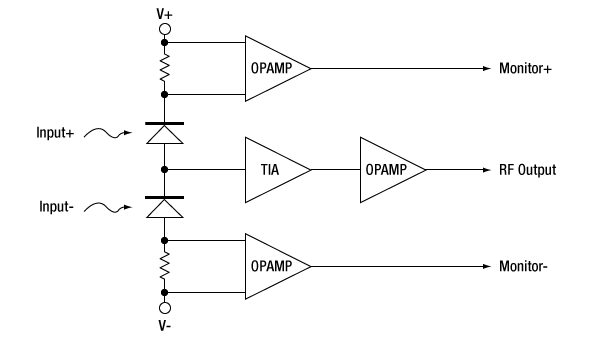
Operation of the PDB480C-AC, PDB481C-AC, and PDB482C-AC Balanced Detectors
The PDB48xC-AC Balanced Amplified Photodetectors use the same basic operating principles as described above and have the following additional features. The TIA's ultra-low distortion output stage supports up to a 2 Vp-p A/D card input range. The two fast monitor outputs can be used to measure not only the individual optical input power levels, but also low frequency modulated signals up to 3 MHz (Item #s PDB480C-AC and PDB481C-AC) or 2.5 MHz (Item # PDB482C-AC). To enable the much higher frequency of these detectors, the photodiodes are connected to the inputs with length-matched fibers, only AC-coupled versions are offered, and capacitors are added to the circuit (as shown below).
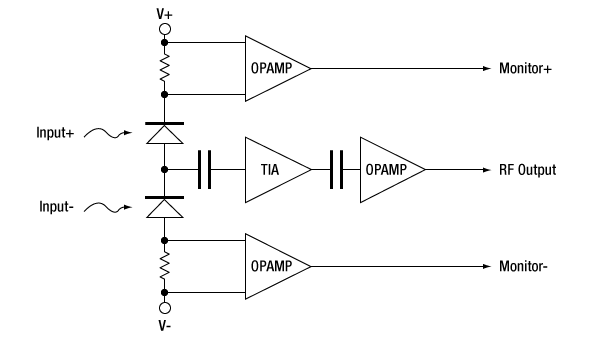
PIN DIAGRAMS
Pin Diagrams for Balanced Amplified Photodetectors
Monitor +/-
SMA Female
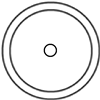
Maximum Voltage is +10 V for Hi-Z & +1.5 V into 50 Ω loads.
RF Output
SMA Female

For the PDB415, PDB425, PDB440, PDB465, and PDB835 photodetectors, the maximum RF OUTPUT voltage is ±3.6 V for Hi-Z & ±1.8 V into 50 Ω loads.
The RF OUTPUT CW saturation power is 420 µW @ 1550 nm and 530 µW at 1060 nm for the PDB470C and PDB471C, respectively.
For the PDB48xC-AC photodetectors, the RF OUTPUT Power at 1 dB compression into 50 Ω loads is +16.5 dBm (Min), +18 dBm (Typical)
PDB Male (Power Cables)
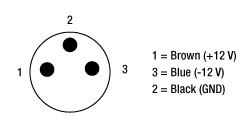
PDB Female (Photodetector)
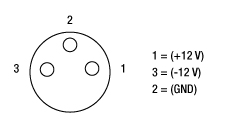
DOPPLER LIDAR
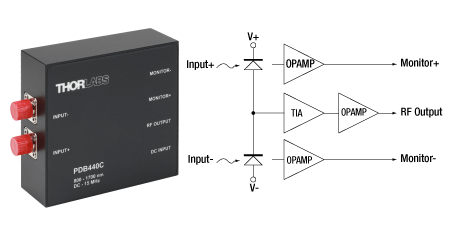
Click to Enlarge
Figure 1. Block Diagram for Thorlabs' Balanced Detectors up to 15 MHz
Application Idea: Doppler LIDAR with Balanced Detector
We demonstrate how to build a Doppler LIDAR (Light Detection and Ranging) system with readily available components manufactured by Thorlabs. The main component is our high-gain balanced photodetector, Item # PDB440C. Balanced detectors are commonly used in applications with high noise levels, which lead to small Signal-to-Noise ratios (SNR).
LIDAR is an ideal application for balanced detectors because they offer common-mode rejection and the usage of both output arms from the 50/50 coupler (described below), which together improve the SNR. Common-mode rejection reduces common-mode noise (for PDB440C, by >25 dB), while using both outputs from the coupler, instead of only one, results in higher signal levels of 3 dB.
The balanced detector consists of two well-matched photodiodes and an ultra-low noise, high-speed transimpedance amplifier (TIA) that generates an output voltage (RF OUTPUT) proportional to the difference between the photocurrents in the two photodiodes.
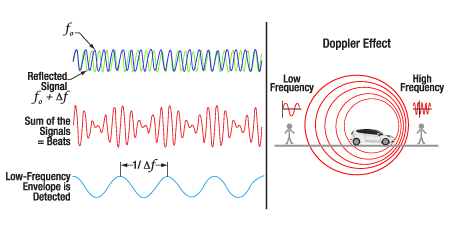
Click to Enlarge
Figure 2. Generation of a beat frequency (left) and principle of the Doppler effect (right).
Theory of Doppler LIDAR
The optical frequency of electromagnetic waves is shifted when reflected from an object in motion. This phenomenon is generally known as the Doppler effect, or, equivalently, as a Doppler shift. When the detector is at a fixed position and the object is moving towards the detector with velocity v, then the Doppler shift Δf can be described as:

Where:
c: Speed of Light (m/s)
f0: Optical Frequency Emitted by Light Source (Hz)

f1: Optical Frequency of Light Reflected from Object (Hz)
In the typical wavelength ranges of our balanced detectors, optical frequencies lie in the THz regime, which are too fast to record directly with photodiodes. On the other hand, consider the following example:

This example shows that for velocities < 0.75 m/s and an optical frequency of 200 THz, which corresponds to a 1500 nm wavelength, the Doppler shift Δf will be in the kHz regime, meaning that the beat frequency from the reference signal (f0) and the Doppler shifted signal (f1) is detectable with standard photodiodes. The detection of two superimposed signals of different frequencies is known as heterodyne detection.
Setup and Principle
The basic components are a fiber-coupled light source with driver, a fiber coupler with a 99/1 coupling ratio, a fiber coupler with a 50/50 coupling ratio, a fiber circulator, a fiber collimator, a balanced detector, an oscilloscope with Fast Fourier Transform capability, and an object moving with velocity v.
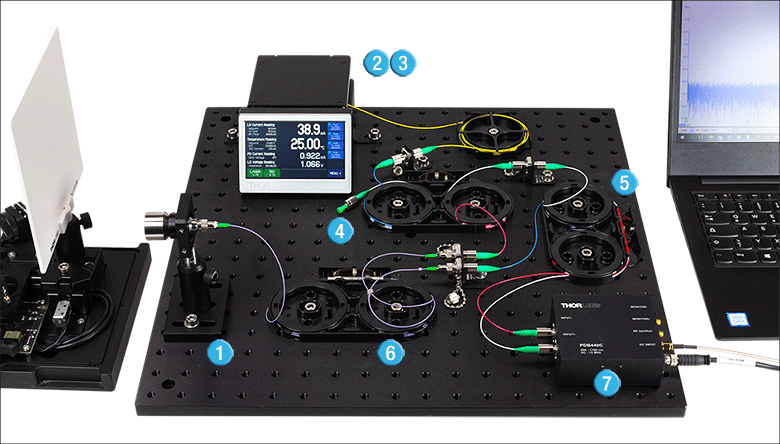
Click to Enlarge
Figure 3. Doppler LIDAR Setup on a Breadboard
| Components | Details | |
|---|---|---|
| 1 | Collimator | F810APC-1550 |
| 2 | Light Source | LP1550-SAD2 DFB Laser with Center Wavelength of 1550.1 nm |
| 3 | LD & TEC Driver | CLD1010LP Compact Laser Diode/Temperature Controller |
| 4 | Fiber Coupler (99/1) | TN1550R1A2 |
| 5 | Fiber Coupler (50/50) | TN1550R5A2 |
| 6 | Fiber Circulator | 6015-3-APC |
| 7 | Detector | PDB440C Balanced Photodetector (CMRR > 35 dB; Gain 51 x 103 V/W) |
| Analyzer | Standard Oscilloscope (with 500 kHz Fast Fourier Transform) or Spectrum Analyzer | |
| Object | EDU-VS1/M Viewing Screen, Mounted on DDSM100/M Linear Stage | |
Light emitted by the LP1550-SAD2 DFB Laser is split by a 99/1 fiber coupler. The 99% arm propagates to the fiber circulator, which directs the light to the fiber collimator for coupling into free space. The collimated beam points towards a moving object with velocity v, and the reflected light is coupled into the fiber. On the way back, the circulator guides the light to the 50/50 fiber coupler, whose other input is the 1% arm of the 99/1 coupler. Both outputs from the 50/50 coupler therefore contain mixed optical signals, which are detected by the PDB440C balanced detector.
Measurement and Results
The linear stage is set to a velocity of 250 mm/s. The resulting signal is a sharp peak with an SNR of more than 10 dB. The velocity is calculated as follows:

The accuracy of the velocity of the linear translation stage has an observed deviation of 9 mm/s (3.5%), which is within the expected range of the configuration.
The object is placed on the DDSM100/M linear translation stage, which has a 100 mm travel range. While moving the object, the velocity is non-constant for an unknown distance, because the linear stage has limited acceleration. Thus, the signal's frequency varies while the object travels from 0 mm to 100 mm. The time duration for one measurement at the analyzer, which is an oscilloscope with fast Fourier transform capability, is some tens of milliseconds, so we do not observe continuous movement of the signal, but rather jumps with non-constant intervals. Therefore, we used the maximum peak hold function to evaluate the correlation of the frequency to the maximum velocity of the object. This function captures the peak with highest amplitude during one frequency scan.
This application idea shows a generic configuration and demonstration of a Doppler LIDAR with Thorlabs components. Please contact techsupport@thorlabs.com for questions and comments regarding the application idea or your application.
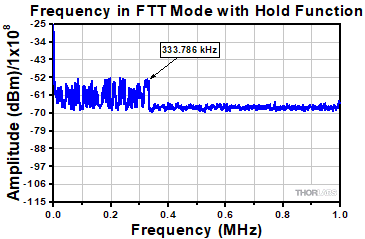
Click to Enlarge
Figure 6. Measurement of the frequency Δf in FFT mode with the oscilloscope max peak hold function.
Switchable Gain with Fast Monitor Output
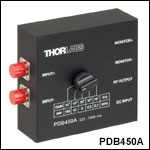
| Specificationsa | ||||
|---|---|---|---|---|
| Item # | PDB450A(-AC) | PDB450C(-AC) | ||
| Detector Type | Si/PIN | InGaAs/PIN | ||
| Wavelength Range | 320 - 1000 nm | 800 - 1700 nm | ||
| Max Responsivity (Typical) | 0.53 A/W | 1.0 A/W | ||
| Active Detector Diameter | 0.8 mm | 0.3 mm | ||
| Bandwidth (3 dB) | DC - 150, 45, 4, 0.3, 0.1 MHz AC Coupled (-AC Suffix): 100 Hz - 150, 45, 4, 0.3, 0.1 MHz |
|||
| Common Mode Rejection Ratio |
>25 dB | |||
| Transimpedance Gainb | 103, 104, 105, 106, 107 V/A | |||
| Minimum NEP | DC - 0.1 MHz: 1.4 pW/Hz1/2 DC - 0.3 MHz: 1.1 pW/Hz1/2 DC - 4.0 MHz: 3.3 pW/Hz1/2 DC - 45 MHz: 28.9 pW/Hz1/2 DC - 150 MHz: 123 pW/Hz1/2 |
DC - 0.1 MHz: 0.7 pW/Hz1/2 DC - 0.3 MHz: 0.5 pW/Hz1/2 DC - 4.0 MHz: 1.55 pW/Hz1/2 DC - 45 MHz: 14.9 pW/Hz1/2 DC - 150 MHz: 68.6 pW/Hz1/2 |
||
| Optical Inputs | FC/PC or FC/APC Compatible (Removable Adapter) | |||
| Monitor Output Bandwidth | DC - 1 MHz | |||
Part Number | Description | Price | Availability |
|---|---|---|---|
PDB450A | Customer Inspired! Switchable Gain Balanced Amp. Photodetector, Si, 320 - 1000 nm | $1,778.88 | Today |
PDB450A-AC | Switchable Gain Balanced Amp. Photodetector, Si, 320 - 1000 nm, AC Coupled | $1,778.88 | Today |
PDB450C | Switchable Gain Balanced Amp. Photodetector, InGaAs, 800 - 1700 nm | $1,901.23 | 7-10 Days |
PDB450C-AC | Switchable Gain Balanced Amp. Photodetector, InGaAs, 800 - 1700 nm, AC Coupled | $1,901.23 | Lead Time |
Bandwidth: DC to 15 MHz with Fast Monitor Output
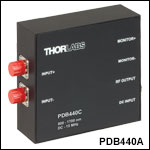
| Specificationsa | ||||
|---|---|---|---|---|
| Item # | PDB440A(-AC) | PDB440C(-AC) | ||
| Detector Type | Si/PIN | InGaAs/PIN | ||
| Wavelength Range | 320 - 1000 nm | 800 - 1700 nm | ||
| Max Responsivity (Typical) | 0.53 A/W | 1.0 A/W | ||
| Active Detector Diameter | 0.8 mm | 0.3 mm | ||
| Bandwidth (3 dB) | DC - 15 MHz AC Coupled (-AC Suffix): 100 Hz - 15 MHz |
|||
| Common Mode Rejection Ratio | >35 dB | |||
| Transimpedance Gainb | 51 x 103 V/A | |||
| Minimum NEP | 6.9 pW/Hz1/2 (DC - 15 MHz) |
3.9 pW/Hz1/2 (DC - 15 MHz) |
||
| Optical Inputs | FC/PC or FC/APC Compatible (Removable Adapter) | |||
| Monitor Output Bandwidth | DC - 1 MHz | |||
Part Number | Description | Price | Availability |
|---|---|---|---|
PDB440A | Fixed Gain Balanced Amp. Photodetector, 15 MHz, Si, 320 - 1000 nm | $1,693.71 | Lead Time |
PDB440A-AC | Fixed Gain Balanced Amp. Photodetector, 15 MHz, Si, 320 - 1000 nm, AC Coupled | $1,693.71 | 7-10 Days |
PDB440C | Fixed Gain Balanced Amp. Photodetector, 15 MHz, InGaAs, 800 - 1700 nm | $1,790.89 | Today |
PDB440C-AC | Fixed Gain Balanced Amp. Photodetector, 15 MHz, InGaAs, 800 - 1700 nm, AC Coupled | $1,790.89 | 7-10 Days |
Bandwidth: DC to 75 MHz with Fast Monitor Output
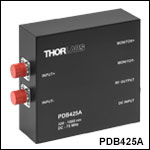
| Specificationsa | ||
|---|---|---|
| Item # | PDB425A(-AC) | PDB425C(-AC) |
| Detector Type | Si/PIN | InGaAs/PIN |
| Wavelength Range | 320 - 1000 nm | 800 - 1700 nm |
| Max Responsivity (Typical) | 0.53 A/W | 1.0 A/W |
| Active Detector Diameter | 0.8 mm | 0.3 mm |
| Bandwidth (3 dB) | DC - 75 MHz AC Coupled (-AC Suffix): 100 Hz - 75 MHz |
|
| Common Mode Rejection Ratio | >35 dB | |
| Transimpedance Gainb | 250 x 103 V/A | |
| Minimum NEP | 9.5 pW/Hz1/2 (DC - 75 MHz) |
5.2 pW/Hz1/2 (DC - 75 MHz) |
| Optical Inputs | FC/PC or FC/APC Compatible (Removable Adapter) | |
| Monitor Output Bandwidth | DC - 1 MHz | |
Part Number | Description | Price | Availability |
|---|---|---|---|
PDB425A | Fixed Gain Balanced Amp. Photodetector, 75 MHz, Si, 320 - 1000 nm | $1,558.16 | Today |
PDB425A-AC | Fixed Gain Balanced Amp. Photodetector, 75 MHz, Si, 320 - 1000 nm, AC Coupled | $1,558.16 | Today |
PDB425C | Fixed Gain Balanced Amp. Photodetector, 75 MHz, InGaAs, 800 - 1700 nm | $1,668.52 | Lead Time |
PDB425C-AC | Fixed Gain Balanced Amp. Photodetector, 75 MHz, InGaAs, 800 - 1700 nm, AC Coupled | $1,668.52 | Today |
Bandwidth: DC to 100 MHz with Fast Monitor Output
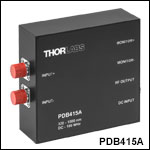
| Specificationsa | ||
|---|---|---|
| Item # | PDB415A(-AC) | PDB415C(-AC) |
| Detector Type | Si/PIN | InGaAs/PIN |
| Wavelength Range | 320 - 1000 nm | 800 - 1700 nm |
| Max Responsivity (Typical) | 0.53 A/W | 1.0 A/W |
| Active Detector Diameter | 0.8 mm | 0.3 mm |
| Bandwidth (3 dB) | DC - 100 MHz AC Coupled (-AC Suffix): 100 Hz - 100 MHz |
|
| Common Mode Rejection Ratio | >25 dB | |
| Transimpedance Gainb | 50 x 103 V/A | |
| Minimum NEP | 12.03 pW/Hz1/2 (DC - 100 MHz) |
6.99 pW/Hz1/2 (DC - 100 MHz) |
| Optical Inputs | FC/PC or FC/APC Compatible (Removable Adapter) | |
| Monitor Output Bandwidth | DC - 1 MHz | |
Part Number | Description | Price | Availability |
|---|---|---|---|
PDB415A | Fixed Gain Balanced Amp. Photodetector, 100 MHz, Si, 320 - 1000 nm | $1,398.63 | 7-10 Days |
PDB415A-AC | Fixed Gain Balanced Amp. Photodetector, 100 MHz, Si, 320 - 1000 nm, AC Coupled | $1,398.63 | Today |
PDB415C | Fixed Gain Balanced Amp. Photodetector, 100 MHz, InGaAs, 800 - 1700 nm | $1,471.80 | 7-10 Days |
PDB415C-AC | Fixed Gain Balanced Amp. Photodetector, 100 MHz, InGaAs, 800 - 1700 nm, AC Coupled | $1,471.80 | Lead Time |
Bandwidth: DC to 200 MHz with Fast Monitor Output
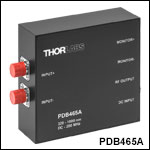
| Specificationsa | ||
|---|---|---|
| Item # | PDB465A(-AC) | PDB465C(-AC) |
| Detector Type | Si/PIN | InGaAs/PIN |
| Wavelength Range | 320 - 1000 nm | 800 - 1700 nm |
| Max Responsivity (Typ.) | 0.50 A/W | 1.0 A/W |
| Active Detector Diameter | 0.8 mm | 0.15 mm |
| Bandwidth (3 dB) | DC - 200 MHz AC Coupled (-AC Suffix): 100 Hz - 200 MHz |
|
| Common Mode Rejection Ratio |
>25 dB | |
| Transimpedance Gainb | 30 x 103 V/A | |
| Minimum NEP | 22.86 pW/Hz1/2 (DC - 200 MHz) |
8.52 pW/Hz1/2 (DC - 200 MHz) |
| Optical Inputs | FC/PC or FC/APC Compatible (Removable Adapter) |
FC/PC or FC/APC Compatible (Adapter is not Removable) |
| Monitor Output Bandwidth | DC - 1 MHz | |
Part Number | Description | Price | Availability |
|---|---|---|---|
PDB465A | Fixed Gain Balanced Amp. Photodetector, 200 MHz, Si, 320 - 1000 nm | $1,717.70 | Lead Time |
PDB465A-AC | Fixed Gain Balanced Amp. Photodetector, 200 MHz, Si, 320 - 1000 nm, AC Coupled | $1,717.70 | 7-10 Days |
PDB465C | Fixed Gain Balanced Amp. Photodetector, 200 MHz, InGaAs, 800 - 1700 nm | $1,693.71 | Today |
PDB465C-AC | Fixed Gain Balanced Amp. Photodetector, 200 MHz, InGaAs, 800 - 1700 nm, AC Coupled | $1,693.71 | Today |
Bandwidth: DC to 350 MHz with Fast Monitor Output
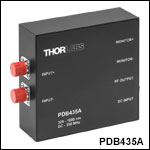
| Specificationsa | ||
|---|---|---|
| Item # | PDB435A(-AC) | PDB435C(-AC) |
| Detector Type | Si/PIN | InGaAs/PIN |
| Wavelength Range | 320 - 1000 nm | 800 - 1700 nm |
| Max Responsivity (Typ.) | 0.50 A/W | 1.0 A/W |
| Active Detector Diameter | 0.4 mm | 0.15 mm |
| Bandwidth (3 dB) | DC - 350 MHz AC Coupled (-AC Suffix): 100 Hz - 350 MHz |
|
| Common Mode Rejection Ratio |
>20 dB | |
| Transimpedance Gainb | 10 x 103 V/A | |
| Minimum NEP | 32.3 pW/Hz1/2 (DC - 350 MHz) |
15.28 pW/Hz1/2 (DC - 350 MHz) |
| Optical Inputs | FC/PC or FC/APC Compatible (Removable Adapter) |
FC/PC or FC/APC Compatible (Adapter is not Removable) |
| Monitor Output Bandwidth | DC - 1 MHz | |
Part Number | Description | Price | Availability |
|---|---|---|---|
PDB435A | Fixed Gain Balanced Amp. Photodetector, 350 MHz, Si, 320 - 1000 nm | $1,778.88 | Today |
PDB435A-AC | Fixed Gain Balanced Amp. Photodetector, 350 MHz, Si, 320 - 1000 nm, AC Coupled | $1,778.88 | Today |
PDB435C | Fixed Gain Balanced Amp. Photodetector, 350 MHz, InGaAs, 800 - 1700 nm | $1,901.23 | Today |
PDB435C-AC | Fixed Gain Balanced Amp. Photodetector, 350 MHz, InGaAs, 800 - 1700 nm, AC Coupled | $1,901.23 | Today |
Bandwidth: DC to 400 MHz with Fast Monitor Output
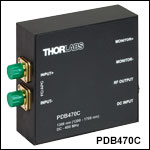
| Specificationsa | ||
|---|---|---|
| Item # | PDB471C(-AC) | PDB470C(-AC) |
| Operating Wavelength | Optimized for 1060 nm (900 - 1400 nm Range) |
Optimized for 1300 nm (1200 - 1700 nm Range) |
| Detector Type | InGaAs/PIN | |
| Internal Coupling Fiber | HI1060 | SMF-28e+ |
| Responsivity (Typical) | 0.72 A/W @ 1060 nm | 0.9 A/W @ 1550 nm |
| Active Detector Diameter | 0.080 mm | 0.075 mm |
| Bandwidth (3 dB) | DC - 400 MHz AC Coupled (-AC Suffix): 100 Hz - 400 MHz |
|
| Common Mode Rejection Ratio | >25 dB (Typ. >30 dB) |
|
| Transimpedance Gainb | 10 x 103 V/A | |
| Minimum NEP | 8 pW/Hz1/2 (DC to 100 MHz) | |
| Optical Inputs | FC/APC | |
| Monitor Output Bandwidth | DC - 3 MHz | |
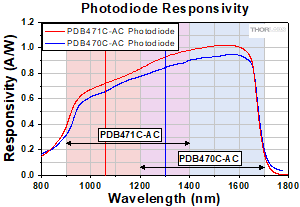
Click to Enlarge
The two vertical lines mark 1060 nm (red) and 1300 nm (blue). The shaded regions indicate the specified wavelength range for each detector.
Part Number | Description | Price | Availability |
|---|---|---|---|
PDB471C | Fiber-Coupled Balanced Amp. Photodetector, 400 MHz, InGaAs, 1060 nm | $2,147.13 | 7-10 Days |
PDB471C-AC | Fiber-Coupled Balanced Amp. Photodetector, 400 MHz, InGaAs, 1060 nm, AC Coupled | $2,147.13 | 7-10 Days |
PDB470C | Customer Inspired! Fiber-Coupled Balanced Amp. Photodetector, 400 MHz, InGaAs, 1300 nm | $2,024.77 | 7-10 Days |
PDB470C-AC | Customer Inspired! Fiber-Coupled Balanced Amp. Photodetector, 400 MHz, InGaAs, 1300 nm, AC Coupled | $2,024.77 | Today |
Bandwidth: DC to 500 MHz with Fast Monitor Output

| Specificationsa | |
|---|---|
| Item # | PDB835C(-AC) |
| Detector Type | InGaAs/PIN |
| Wavelength Range | 800 - 1700 nm |
| Max Responsivity (Typical) | 1.0 A/W @ 1550 nm |
| Active Detector Diameter | 0.08 mm |
| Bandwidth (3 dB) | DC - 500 MHz AC Coupled (-AC Suffix): 1 kHz - 500 MHz |
| Common Mode Rejection Ratio | >25 dB |
| Transimpedance Gainb | 10 x 103 V/A |
| Minimum NEP | 6.5 pW/Hz1/2 (DC to 500 MHz) |
| Optical Inputs | FC/APC |
| Monitor Output Bandwidth | DC - 1 MHz |
Part Number | Description | Price | Availability |
|---|---|---|---|
PDB835C | Customer Inspired! Fixed Gain Balanced Amp. Photodetector, 500 MHz, InGaAs, 800 - 1700 nm | $1,989.00 | Today |
PDB835C-AC | Customer Inspired! Fixed Gain Balanced Amp. Photodetector, 500 MHz, InGaAs, 800 - 1700 nm, AC Coupled | $1,989.00 | Lead Time |
Bandwidth: 30 kHz to 1 GHz or 1.6 GHz with Fast Monitor Output
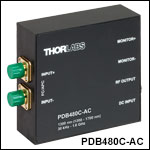
| Specificationsa | ||
|---|---|---|
| Item # | PDB481C-AC | PDB480C-AC |
| Operating Wavelength | Optimized for 1060 nm (900 - 1400 nm Range) |
Optimized for 1300 nm (1200 - 1700 nm Range) |
| Detector Type | InGaAs/PIN | |
| Internal Coupling Fiber | HI1060 | SMF-28e+ |
| Responsivity (Typical) | 0.72 A/W @ 1060 nm | 0.9 A/W @ 1550 nm |
| Active Detector Diameter | 0.080 mm | 0.075 mm |
| Bandwidth (3 dB) | 30 kHz - 1.0 GHz | 30 kHz - 1.6 GHz |
| Common Mode Rejection Ratio |
>25 dB (Typ. >30 dB) |
|
| Transimpedance Gainb | 16 x 103 V/A | |
| Minimum NEP | 9.0 pW/Hz1/2 (30 kHz to 100 MHz) |
9.3 pW/Hz1/2 (30 kHz to 100 MHz) |
| Optical Inputs | FC/APC | |
| Monitor Output Bandwidth | DC - 3 MHz | |
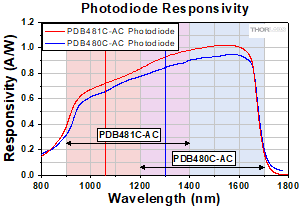
Click to Enlarge
The two vertical lines mark 1060 nm (red) and 1300 nm (blue). The shaded regions indicate the operating wavelength range for each detector.
Part Number | Description | Price | Availability |
|---|---|---|---|
PDB481C-AC | Fiber-Coupled Balanced Amp. Photodetector, 1.0 GHz, InGaAs, 1060 nm, AC Coupled | $2,147.13 | Today |
PDB480C-AC | Fiber Coupled Balanced Amp. Photodetector, 1.6 GHz, InGaAs, 1300 nm, AC Coupled | $2,036.78 | Lead Time |
Bandwidth: 1 MHz to 2.5 GHz with Fast Monitor Output
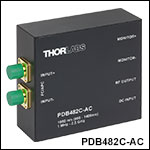
| Specificationsa | |
|---|---|
| Item # | PDB482C-AC |
| Operating Wavelength | Optimized for 1060 nm (900 - 1400 nm Range) |
| Detector Type | InGaAs/PIN |
| Internal Coupling Fiber | HI1060 |
| Responsivity (Typical) | 0.72 A/W @ 1060 nm |
| Active Detector Diameter | 0.080 mm |
| Bandwidth (3 dB) | 1 MHz - 2.5 GHz |
| Common Mode Rejection Ratio | >20 dB (>25 dB Typ.) |
| Transimpedance Gainb | 28 x 103 V/A |
| Minimum NEP | 12.0 pW/Hz1/2 (1 MHz to 100 MHz) |
| Optical Inputs | FC/APC |
| Monitor Output Bandwidth | DC - 2.5 MHz |
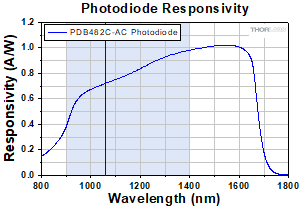
Click to Enlarge
The vertical line marks the detector's optimized wavelength (1060 nm) while the shaded region indicates the operating wavelength range.
Part Number | Description | Price | Availability |
|---|---|---|---|
PDB482C-AC | Fiber-Coupled Balanced Amp. Photodetector, 2.5 GHz, InGaAs, 1060 nm, AC Coupled | $2,147.13 | Today |
±12 VDC Regulated Linear Power Supply

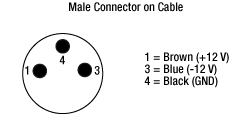
- Replacement Power Supply for the Balanced Amplified Photodetectors Sold Above
- ±12 VDC Power Output
- Current Limit Enabling Short Circuit and Overload Protection
- On/Off Switch with LED Indicator
- Switchable AC Input Voltage (100, 120, or 230 VAC)
- 2 m (6.6 ft) Cable with LUMBERG RSMV3 Male Connector
- UL and CE Compliant
The LDS12B ±12 VDC Regulated Linear Power Supply is intended as a replacement for the supply included with our PDB line of balanced photodetectors sold on this page. The cord has three pins: one for ground, one for +12 V, and one for -12 V (see diagram above). This power supply ships with a location-specific power cord. This power supply can also be used with the PDA series of amplified photodetectors, PMM series of photomultiplier modules, APD series of avalanche photodetectors, and the FSAC autocorrelator for femtosecond lasers.
Part Number | Description | Price | Availability |
|---|---|---|---|
LDS12B | ±12 VDC Regulated Linear Power Supply, 6 W, 100/120/230 VAC | $93.55 | Today |

